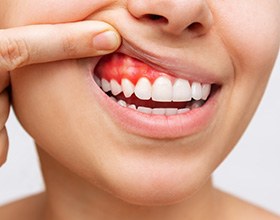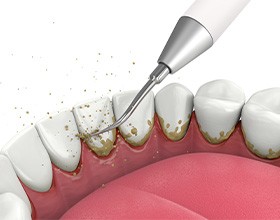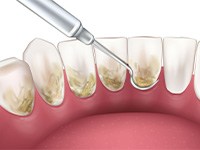Gum Disease Treatment – Boca Raton, FL
Keeping Your Gums Safe from Infections

Many folks now don’t see the gums as a vital part of the mouth. However, the truth is that these tissues support and protect your teeth; they’re crucial to your long-term oral health. That’s why our practice offers quality gum disease treatment here in Boca Raton! Using this procedure, we’ll look after your gum tissues and keep them strong and healthy. Please find out more by reading below, or book a consultation with us today!
Why Choose Us for Gum Disease Treatment?
- Decades of Experience Providing Specialized Dental Care
- Dedicated Hygienists Trained for Periodontal Treatment
- Targeted Periodontal Screenings That Catch Infections Early
What is Gum Disease?

Gum disease is an infection of your gums, the soft tissue surrounding your teeth. It occurs as plaque – a film of harmful bacteria – builds in your mouth due to a poor diet and bad oral hygiene. Of course, the disease also has major risk factors like genetics, tobacco use, hormone changes, etc.
Typically, gum disease develops in two stages. The first one is gingivitis, a mild inflammation of the gums. Stage two of the disease is periodontitis – a severe infection that attacks your jaw and gum tissues. While gingivitis can be reversed with good oral care, dentistry can only manage periodontitis.
Symptoms of Gum Disease

Due to having two stages, gum disease can cause a wide range of symptoms. The signs a patient shows will depend on their condition’s severity and progress.
For instance, consider gingivitis. This phase’s common signs are:
- Red, bleeding gums
- Swollen gums
- Gum tenderness
- Gum recession
- Halitosis (i.e., chronic bad breath)
The symptoms of periodontitis tend to be much harsher. They include:
- Tooth sensitivity (often due to gum recession)
- A shift in your bite
- Chewing pain
- Changes in your restoration’s fit
- Loose permanent teeth
- Permanent tooth loss
How Do We Treat Gum Disease?

Before treatment, Dr. Lamberti will perform an oral exam to assess your mouth. Doing so lets him see the state of your gums – whether they’re inflamed, sensitive, etc. Based on his findings, he’ll then be ready to suggest one (or more) of the following treatments:
Scaling & Root Planing

Depending on what stage your gum disease is currently in, we may recommend scaling and root planing, which are often collectively referred to as deep cleaning. With scaling and root planing, we can address the root of gum disease by getting rid of bacteria that are hiding in areas that can’t be effectively cleaned with regular brushing or flossing practices. This procedure can also reduce the chances of a new infection occurring, thus protecting your oral health in the long term.
Do I Need Scaling & Root Planing?

Scaling and root planing may be necessary if any of the following symptoms sound familiar:
- Your gums frequently bleed when you’re brushing or flossing your teeth.
- Your teeth look longer than normal, which is a consequence of receding gum tissue.
- You constantly have bad breath or notice a bad taste in your mouth.
- Your teeth have noticeably shifted.
- You have had trouble chewing your food lately.
Gum disease is not a problem that you can afford to ignore for very long. As soon as you have reason to think that you might have it, you should get in touch with our office so that we can determine whether scaling and root planing are necessary.
The Process of Scaling & Root Planing

Scaling is the first phase of the treatment. Using special dental instruments, we will carefully remove any plaque and tartar that has built up in your mouth. We’ll mainly focus on the areas around and beneath the gums. If pockets have formed between your teeth and your gums, we’ll clean as far down into them as we can.
The next step is root planing. This is where we take the tooth roots – which are typically covered by the gums – and smooth them out. Smoother tooth roots have two important benefits. First, it helps the gums attach themselves to the teeth again. And second, it makes it harder for bacteria to build up on the roots, which effectively lowers your risk for reinfection.
Aftercare Tips for Scaling & Root Planing

We will use a local anesthetic to keep you comfortable during scaling and root planing. Once your procedure is over, your mouth may still be numb; as such, to avoid biting your tongue by accident, you should wait at least a couple of hours before trying to eat again.
Our team will give you tips for taking care of your gums in the days following your deep cleaning. Some steps that you’ll need to follow include:
- Using salt water to rinse your mouth at regular intervals.
- Being careful when brushing around the area where scaling and root planing were performed.
- Eating only soft foods for at least a couple of days.
- Staying away from any foods that are particularly spicy or acidic.
- Taking an over-the-counter pain reliever to keep your discomfort under control.
Arestin® Antibiotic Therapy

After an initial periodontal cleaning, we may apply a topical antibiotic to your gums to eliminate bacteria beneath the gum line. This medicine is called Arestin – a powdery material that consists of thousands of tiny microspheres, each filled with a powerful antimicrobial agent. It dries quickly once applied and slowly dissolves over a few days, reaching and killing the leftover bacteria.